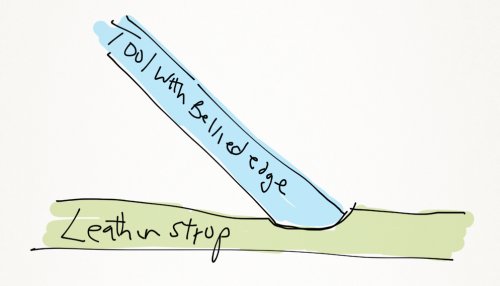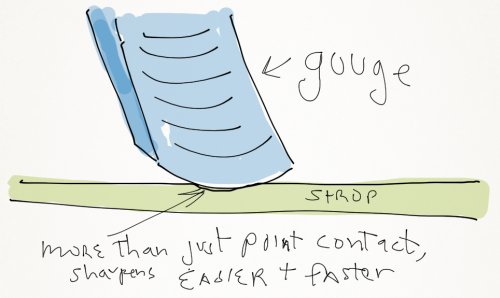 In my last missive on the subject of sharpening I pointed out that when a tool has a belly for a bevel it's easy to sharpen ineffectively. The problem is of course that stones and sandpaper are hard surfaces and you get a point contact with anything except a straight line. Carvers have an even worse problem when sharpening any gouge. At best, with a perfectly straight bevel, they have at most a line of contact along the curvature of the gouge. There are tons of techniques for sharpening carving tools on a stone but for routine maintenance the go-to tool of every carver is a strop. In my last missive on the subject of sharpening I pointed out that when a tool has a belly for a bevel it's easy to sharpen ineffectively. The problem is of course that stones and sandpaper are hard surfaces and you get a point contact with anything except a straight line. Carvers have an even worse problem when sharpening any gouge. At best, with a perfectly straight bevel, they have at most a line of contact along the curvature of the gouge. There are tons of techniques for sharpening carving tools on a stone but for routine maintenance the go-to tool of every carver is a strop.
A strop is a piece of leather that is either plain or treated with a very fine abrasive. Unlike the hard surface of a stone, when you put your tool on the strop the leather gives, you get more than a point contact and you hone a much larger area of the tool at the same time. If you have treated your strop by rubbing it with a fine abrasive, usually in the form of a honing compound on a wax stick, you effectively make the strop into an abrasive hone that will  conform to the curvature, both front to back and left to right or any edge tool. conform to the curvature, both front to back and left to right or any edge tool.
The advantage to carvers is that with a strop you can sharpen faster and much easier than you can with stones. The advantage for cabinetmakers and joiners is that if your tool has a rounded bevel, or you were just sharpening ineffectively, you now have a way to actually sharpen at the cutting edge without having perfect technique. The strop glosses over inconsistencies in honing and gets you an edge, fast.
There is a trade off -- The bevel of the tool will be more rounded over time. This isn't a big deal for carving tools, but for cabinetmaker's tools you can easily round the bevel more or make the back of the tool convex. Another use for a strop is to wear away any wire edge the you created with your stones. However with a treated strop, which is an abrasive in itself, you also run the risk of creating even more wire edge. To solve that problem I use an untreated, that is plain, strop.
Another point to consider is your average honing compound is coarser than the best finishing stones. If you sharpen to 6000 grit, or with a diamond stone, a treated strop will be finer and give you a finer edge. However if you use a 8000 grit stone, and work it effectively, or a top notch Arkansas stone, a treated stop might make your tool duller. This is a problem that is easily dealt with but I think I should write a bit about strops themselves and stropping compounds. I'll do that in the near future.
When you strop you are stroking a fairly sharp cutting edge against an easily damaged piece of leather. In Maurice Fraser's article on sharpening he details techniques for effective stropping.
|
 Joel's Blog
Joel's Blog Built-It Blog
Built-It Blog Video Roundup
Video Roundup Classes & Events
Classes & Events Work Magazine
Work Magazine


 In my
In my  conform to the curvature, both front to back and left to right or any edge tool.
conform to the curvature, both front to back and left to right or any edge tool.
The reason why the shapton and chosera stones cut that much faster, are a combination of the concentration of abrasive particles and the curing process that these stones are put through, in their manufacturing process. Their stones are also very closely graded, where there is not a large gap between the stated particular size of the stone.